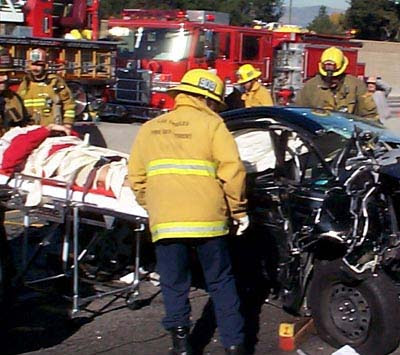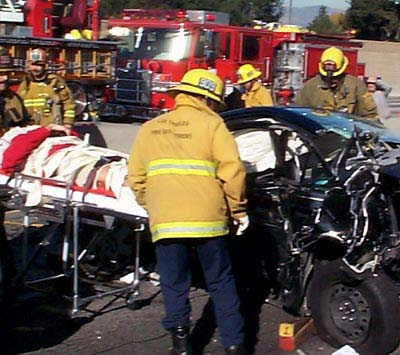
The first one hour after a critical and serious road accident is the most crucial time that whether the injured person would survive or not.
It is called the Golden Hour during which a critically injured driver or passenger must receive medical treatment in order to increase their chances of survival. Hence every second counts and any delay can mean the difference between life and death when emergency medical personnel respond to a major car crash.
With the aim of providing victims of serious car accidents the critical treatment that they require in the first hour, Toyota has announced the launch of the new trial service in Japan. The Japanese auto giant would launch the initiative in partnership with the nonprofit organization Emergency Medical Network of Helicopter and Hospital (HEM-Net) and the Japan Mayday Service Company.
The new initiative called D-Call service is designed in a such way that it allows for the estimation of the probability of death or serious injuries to vehicle occupants based on data from a crash as well as past auto accidents and using newly developed algorithm apart from dispatching air and ground ambulances to the scene of an accident as quickly as possible.
This data is first sent instantly to nearby hospitals to help them decide the severity of the crash and consequently help in better deciding whether to dispatch air or ground ambulances so that the injured person has a better chance of surviving the accident.
Since 2000, a telematics-style auto accident emergency response system called Help Net has been provided by Japan Mayday Service. The system can pinpoint the location of the collision and automatically transmit route data to an emergency response operation center, when a car crash occurs in which airbags are deployed.
The system also allows Help Net operators to connect and communicate with the vehicle occupants and connect them with emergency responders such as a local police or fire department.
The new trial system of Toyota has the added ability of sending vehicle data to a Mayday Service operation center and is essentially an expansion of the existing Help Net service.
The new system can detect and relay vehicle information like the vehicle’s direction of travel, the severity of the collision and whether or not seat belts were being worn.
The service can better determine the probability of death or serious injury in a collision by combining and comparing the vehicle data with the estimation algorithm that uses data from 2.8 million accidents.
In order to develop nationwide participation in D-Call Net by hospitals equipped with air ambulances, HEM-Net is working with the national and local governments in Japan and Mayday Service. In the initial trial phase nine Japanese hospitals that are also air ambulance bases have agreed to participate.
While the new Lexus LX, RX, GS, and GS F are compatible with the D-Call service, Toyota’s Land Cruiser and Crown models in Japan were redesigned in the last few months to work with the service. Since June 2013, the Honda Accord equipped with a Honda-brand navigation system has been compatible with the D-Call Net function via a Bluetooth-connected mobile phone.
IN order to expand the range of supported vehicles, Toyota and Honda are coordinating with other automakers to promote the adoption of D-Call Net.
It is expected that around 40,000 vehicles in Japan would be compatible with D-Call Net by 2017.
(Source:www.forbes.com)
It is called the Golden Hour during which a critically injured driver or passenger must receive medical treatment in order to increase their chances of survival. Hence every second counts and any delay can mean the difference between life and death when emergency medical personnel respond to a major car crash.
With the aim of providing victims of serious car accidents the critical treatment that they require in the first hour, Toyota has announced the launch of the new trial service in Japan. The Japanese auto giant would launch the initiative in partnership with the nonprofit organization Emergency Medical Network of Helicopter and Hospital (HEM-Net) and the Japan Mayday Service Company.
The new initiative called D-Call service is designed in a such way that it allows for the estimation of the probability of death or serious injuries to vehicle occupants based on data from a crash as well as past auto accidents and using newly developed algorithm apart from dispatching air and ground ambulances to the scene of an accident as quickly as possible.
This data is first sent instantly to nearby hospitals to help them decide the severity of the crash and consequently help in better deciding whether to dispatch air or ground ambulances so that the injured person has a better chance of surviving the accident.
Since 2000, a telematics-style auto accident emergency response system called Help Net has been provided by Japan Mayday Service. The system can pinpoint the location of the collision and automatically transmit route data to an emergency response operation center, when a car crash occurs in which airbags are deployed.
The system also allows Help Net operators to connect and communicate with the vehicle occupants and connect them with emergency responders such as a local police or fire department.
The new trial system of Toyota has the added ability of sending vehicle data to a Mayday Service operation center and is essentially an expansion of the existing Help Net service.
The new system can detect and relay vehicle information like the vehicle’s direction of travel, the severity of the collision and whether or not seat belts were being worn.
The service can better determine the probability of death or serious injury in a collision by combining and comparing the vehicle data with the estimation algorithm that uses data from 2.8 million accidents.
In order to develop nationwide participation in D-Call Net by hospitals equipped with air ambulances, HEM-Net is working with the national and local governments in Japan and Mayday Service. In the initial trial phase nine Japanese hospitals that are also air ambulance bases have agreed to participate.
While the new Lexus LX, RX, GS, and GS F are compatible with the D-Call service, Toyota’s Land Cruiser and Crown models in Japan were redesigned in the last few months to work with the service. Since June 2013, the Honda Accord equipped with a Honda-brand navigation system has been compatible with the D-Call Net function via a Bluetooth-connected mobile phone.
IN order to expand the range of supported vehicles, Toyota and Honda are coordinating with other automakers to promote the adoption of D-Call Net.
It is expected that around 40,000 vehicles in Japan would be compatible with D-Call Net by 2017.
(Source:www.forbes.com)





